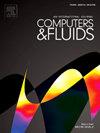Perturbed polynomial reconstructed seventh-order hybrid WENO scheme with improved accuracy and resolution
IF 2.5
3区 工程技术
Q3 COMPUTER SCIENCE, INTERDISCIPLINARY APPLICATIONS
引用次数: 0
Abstract
Non-polynomial reconstructions can be employed to enhance the performance of the WENO-type schemes by optimizing the inherent hyper-parameter. In contrast to the non-polynomial RBF-based and the Gauss-Kriging reconstructions, the perturbed polynomial reconstruction exhibits good portability and expandability. In this work, a novel seventh-order WENO scheme, denoted as the HPWENO7 scheme, is proposed by incorporating the concept of the perturbed polynomial reconstructions into the standard seventh-order WENO7-JS scheme (Jiang and Shu, 1996, [6]). Firstly, a refined troubled cell indicator is developed to categorize the global stencils as either smooth or non-smooth. Subsequently, perturbed polynomial reconstruction with double free-parameters, the values of which can be adjusted automatically according to the features of local regions, is developed to optimize the fluxes within the four-point candidate stencils. Adaptive optimization of the free-parameter values enables a minimum one-order improvement in accuracy. Finally, the novel HPWENO7 scheme is proposed by combining the seventh-order upstream central scheme for smooth stencils with the perturbed polynomial reconstruction optimized candidate fluxes for non-smooth stencils. Numerical examples show that the HPWENO7 scheme achieves fifth-order of accuracy in the four-point candidate stencils, providing sharper solutions for discontinuities and significantly higher resolution for small-scale vortex structures around the discontinuities.
求助全文
约1分钟内获得全文
求助全文
来源期刊

Computers & Fluids
物理-计算机:跨学科应用
CiteScore
5.30
自引率
7.10%
发文量
242
审稿时长
10.8 months
期刊介绍:
Computers & Fluids is multidisciplinary. The term ''fluid'' is interpreted in the broadest sense. Hydro- and aerodynamics, high-speed and physical gas dynamics, turbulence and flow stability, multiphase flow, rheology, tribology and fluid-structure interaction are all of interest, provided that computer technique plays a significant role in the associated studies or design methodology.
 求助内容:
求助内容: 应助结果提醒方式:
应助结果提醒方式:


